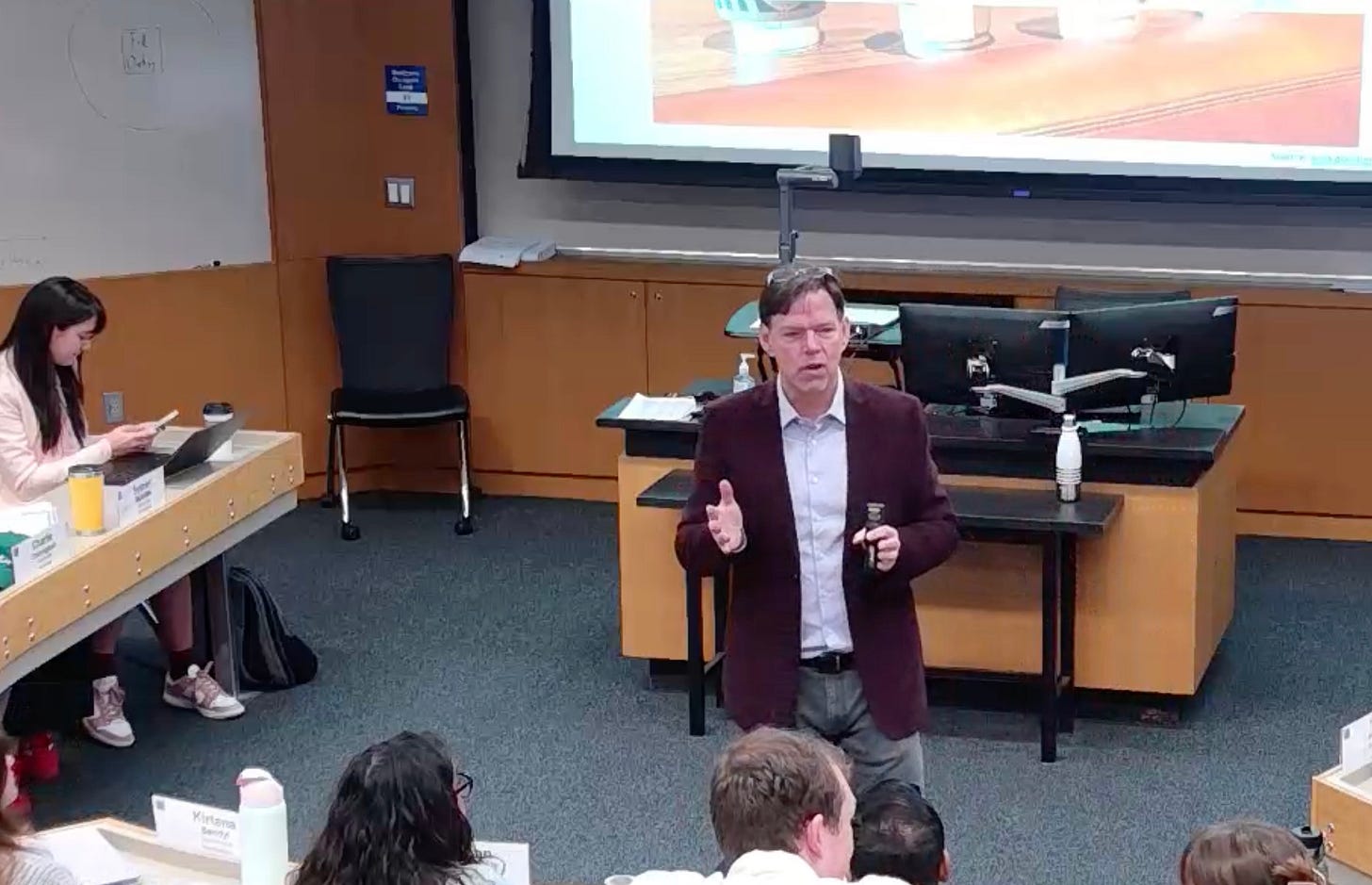Class 2 Recap: Confronting the Corporation - Profits, Power, Society, and the Environment
Part of my insider series tracking the conversations in my MBA course "Climate, Sustainability, and Corporate Governance"
In our second session of Climate, Sustainability, and Corporate Governance, the conversation spanned four centuries and two continents. We began with a $7 latte and ended with the British East India Company, one of the world’s first multinational corporations. Along the way, students wrestled with wicked problems, fiduciary duty, and the messy boundaries of corporate accountability.
The Starbucks Latte and the Wicked Problem of Sustainability
In out first class, Starbucks case proved a rich starting point. What looks like a simple consumer product is, in reality, entangled in a global system of coffee farmers, supply chains, energy-intensive retail stores, and brand-driven consumer psychology.
In our recap this week, students were quick to note that Starbucks faces a wicked problem: there is no single “fix” that resolves its environmental and social footprint. Should the company focus on recyclable cups, more efficient stores, or on shoring up the long-term viability of coffee crops threatened by climate change?
The class drew a critical distinction between what consumers see and what actually moves the needle. Customers notice cups, straws, and store energy usage. But the largest impacts are often invisible: agricultural practices, water stress, farmer livelihoods. We noted how Walmart’s behind-the-scenes efficiencies as an example of how much companies can do without consumers ever noticing - but also wanting to “get credit” for these efforts to improve their sustainability performance.
The dilemma is strategic: do companies chase symbolic wins that reassure consumers, or do they pursue systemic change that alters the underlying business model—even if no one notices?
Corporations as Legal Fictions: Lessons from the East India Company
See the British East India case summary here.
After wrapping up the Starbucks discussion, we jumped all the way back to the seventeenth century. In our case, the British East India Company (BEIC) was granted a royal charter that gave it extraordinary powers: to wage war, collect taxes, even mint currency. This organizational innovation combined permanent joint stock, limited liability, tradable shares, and corporate governance in a truly novel way, and paved the way for the current version of the corporation. What emerged was a hybrid of corporation, government, and military, blurring the line between private enterprise and public authority.
In class, this sparked a deeper question: what is a corporation, anyway? Is it merely a legal fiction created by governments, or does it carry broader social obligations because of the power it wields?
Fiduciary Duty: Who’s Inside the Circle?
The debate turned to fiduciary duty. For BEIC, the duty was straightforward—maximize returns to shareholders. But who else should have been “inside the circle”? The Crown? Indian farmers? British soldiers?
Students debated whether fiduciary duty should be tightly bounded (shareholders only) or porous, extending to communities, workers, and ecosystems. The contrast between Delaware’s single materiality standard and Europe’s double materiality approach underscored how contested this space remains.
The key tension: is fiduciary duty a fixed legal obligation, or is it evolving with society’s expectations?
From Colonial Corporations to Today’s Giants
The parallels students drew between BEIC and today’s firms were striking.
Oil & gas companies: resource extraction, climate externalities.
Tech platforms: monopolization, surveillance, data power.
Fast fashion: labor exploitation, environmental waste.
Pharma and seafood industries: ethical dilemmas around access and depletion.
One student asked pointedly: Have we really progressed in corporate governance, or are we replaying old patterns with new actors?
The consensus: transparency and accountability are stronger today, but the systemic risks—power concentration, externalized costs, fragile legitimacy—remain eerily familiar.
Materiality as a Moving Target
To ground the discussion in modern governance, we mapped the evolution of materiality:
In the 1930s, materiality meant financial disclosure to protect investors.
By the early 2000s, it expanded to cover ESG risks that could hit the bottom line.
Today, in Europe and elsewhere, it has stretched further: double materiality, recognizing that companies impact the world in ways that may not show up immediately on financial statements, and are dynamic over time.
Having set the stage, the class launched into an exercise to map the materiality issues of prominent companies across industries (e.g. Mars, Cisco, Nestle, L’Oreal, and Rio Tinto): for their target company, each team identified the five most material issues, and the three stakeholders they would consult to validate those choices. The exercise surfaced both practical challenges (who counts as a stakeholder?) and conceptual ones (when does an “immaterial” issue suddenly become material?).
The Bigger Thread: Governance and Power
Beneath these cases, a throughline emerged: governance is an inseparable dimension of sustainability, though is often overlooked. Whether Starbucks deciding where to intervene, or BEIC balancing shareholder profit with imperial politics, the real issue is who corporations are accountable to—and who gets left out of the circle.
Closing Reflection
In the span of one session, students traveled from a $7 latte to the colonial foundations of modern capitalism. The questions they surfaced are the same ones haunting boardrooms and parliaments today:
Do we measure success by what consumers see, or by what actually matters?
Is fiduciary duty a narrow obligation or a contested space?
And most fundamentally: who are corporations really for?
These questions will continue to emerge throughout semester. If Starbucks is about symbol vs. substance, and BEIC is about power and accountability, then the arc of the course is clear: sustainability is increasingly material to modern companies, and is neglected at their peril.



https://www.forbes.com/sites/sap/2024/05/14/why-the-rise-of-sustainability-is-a-shift-in-consumer-conciousness/
Such interesting information and thrilled that our MBA students are recognizing such.
Man, would I love to be a fly on the wall!!